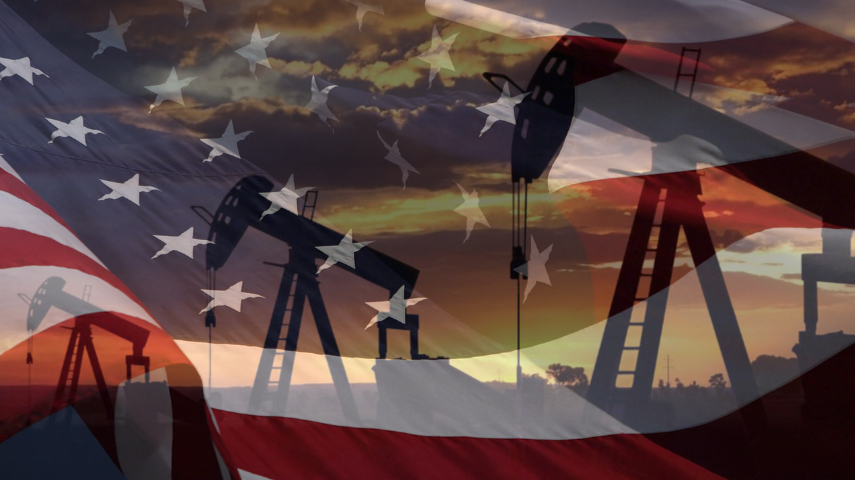C.J. Atkins
Along with trying to militarily absorb Ukraine into NATO, another major factor that’s becoming more apparent in the Biden administration’s unceasing talk of war with Russia is the desire of US energy producers to invade European markets with fracked natural gas.
Though the mainstream press is saturated with talk of a forever-imminent Russian assault on Ukraine and speculate about Moscow’s supposed desire to freeze Europe by cutting off gas supplies, few reporters in the corporate media are asking who stands to gain economically from the standoff in the east.
Put together a few pieces of the puzzle, though, and some clear winners begin to emerge in the Ukraine crisis, whether or not there is an actual war: multinational gas and oil corporations. And it would appear that their industry has found the most powerful spokesperson in the world to represent their interests – the United States government.
Companies like Chevron, ExxonMobil and Shell, along with the hundreds of drilling and shipping contractors that work with them, want to massively step-up exports to a Europe starving for gas, but standing in the way is Russia and its state-owned Gazprom company. Currently, Russian natural gas accounts for over 30 percent of all imports into the European Union. Leading EU powers Germany and France get 40 percent of their gas from Russia, while some other countries, like the Czech Republic and Romania, use only Russian gas.
In order to dislodge the competition and grab market share, the Western multinationals need to slow the flow of gas from the east. And when it comes to incentives, the energy giants have plenty.
Market opportunity
World market prices for natural gas have skyrocketed in recent months, driven by several factors: record high demand in Europe and Asia as manufacturing recovers from the pandemic, constrained supply as some facilities only begin to come back online, depleted reserves due to a long and cold winter in 2020 and the shift of countries like China and Germany away from dirtier fossil fuels like coal and always-unpopular nuclear power.
US producers want to get in on the bonanza, especially in Europe, where gas prices rose five-fold in 2021. The US is the world’s biggest gas producer, extracting more from the ground by the day. That’s especially been the case since 2005, when production – which had been relatively flat for decades – soared.
That’s when the Environmental Protection Agency (EPA) under President George W. Bush declared that hydraulic fracturing of shale to release underground gas posed no threat to drinking water supplies. The environmentally damaging practice, known as “fracking,” really took off once a Republican-dominated Congress passed a law prohibiting any future regulation of fracking. The government’s Energy Information Administration estimates that almost all the gains in US gas production since then are thanks to fracking.
Seeing natural gas as a way to meet green(er) energy goals and achieve emissions targets, the Obama administration encouraged the shale gas boom and resisted calls from the environmental movement and progressives in the Democratic Party to ban fracking. By the end of his time in office, natural gas accounted for a third of US power generation, mostly at the expense of coal.
Gushing with gas, US producers these days increasingly look to Europe as a customer, and the US government has eagerly acted as salesman. Thanks to a 2018 agreement concluded between the Trump administration and the EU, US gas sales to Europe have been steadily climbing, from 16 percent of EU imports in 2019 to 28 percent at the end of 2021.
There’s a problem that could cap the growth, however: US natural gas is expensive.
Hydraulic fracking adds to production costs substantially. Plus, in order to be exported to international customers, US gas has to be liquefied and loaded/unloaded on tanker ships at pricey specialized terminals. Turning fracked shale gas into liquefied natural gas (LNG) can more than double the cost for American companies, putting them at a disadvantage against cheap Russian gas that travels via pipelines.
And one international pipeline project, known as Nord Stream 2, stands as a particularly threatening constraint on US sales. Constructed jointly by Germany and Russia under the Baltic Sea, the pipeline would provide easy and affordable access to gas for the EU. For Russia, it is a guaranteed means of accessing its biggest buyers. For both the EU and Russia, Nord Stream 2 is a way to bypass the added costs of middleman Ukraine, whose territory current pipelines pass through. Once operational, it will carry more than double the amount of Russian gas that currently flows under the Baltic.
A convenient crisis
How convenient then that tensions between the US and its Ukrainian ally on one side and Russia on the other heated up just as the finishing touches were being put on Nord Stream 2 in late 2021. With its own pipeline revenues in trouble, the right-wing government of Ukraine lobbied Washington all summer last year to impose sanctions on Nord Stream 2 and the German and Russian companies behind it.
The House and Senate delivered for Ukraine’s rulers, slipping the desired sanctions into a defense spending bill. Biden – knowing both that his European allies were staunchly opposed to anything threatening their energy supplies and that the infrastructure simply wasn’t in place on either side of the Atlantic yet to fill the gap left by a sudden drop in Russian supplied-gas – said he wouldn’t approve Nord Stream 2 sanctions.
Republican and Democratic lawmakers alike in Congress pushed back, presenting sanctions as a way to “deter Russian aggression against Ukraine.” Senator Ted Cruz of Texas – who represents the top fracked gas-producing state in the US and ranks #1 in campaign donations from the industry – has been one of the strongest sanctions advocates. He’s blocked more than 50 Biden nominations for the State Department and other government positions in retaliation for the president’s waiving of sanctions.
The Biden administration appreciates reality enough to know that it’s probably too late to totally stop Nord Stream 2. The longer the project can be delayed and the more that fear of a Russian chokehold can be increased, however, the more time US gas producers will have to capitalize on the situation.
Endless warnings of an “imminent” Russian invasion and the rushing of NATO troops and weapons to eastern Europe are doing the trick. And with Europe’s energy security put at risk by supposed Russian aggression, who is standing by to render assistance? None other than the US gas industry, of course.
In the pages of the Wall Street Journal last week, Frank J. Macchiarola, head of the American Petroleum Institute, announced that “US oil and natural gas producers can help” defuse the war danger. Macchiarola, the industry’s chief lobbyist in Washington, said that “America is positioned to provide stability amid any energy disruption.” Numbers show that his clients are answering the call.
Spurred on by the Ukraine crisis and increased sales to Europe, the US became the world’s top exporter of LNG for the first time ever in January. The corporate press was quick to blast out the message and said even more US gas must be rushed to Europe to guard against “Russian energy blackmail” – despite the fact that Gazprom has complied with the contracted export volumes agreed to with its European customers.
Germany has remained slow to get on board with the US-NATO war drive and is reluctant to put Nord Stream 2 in danger. Even if expensive US gas imports increase, they’re not enough to heat Germany’s homes and power its factories – by far. Nor are they affordable. The country will still need other sources of energy.
That isn’t stopping Biden from elbowing Chancellor Olaf Scholz to put a pause on the pipeline and get in line with the NATO campaign in Ukraine. Biden pledged that if Putin sent troops into Ukraine “there would be no Nord Stream 2.”
Scholz isn’t caving, but a number of concessions have been made to possibly satisfy Biden and Ukrainian President Volodymyr Zelensky, at least for now. A range of new delays, many based on technicalities, have pushed the pipeline’s activation date late into 2022. And last weekend, Germany announced the revival of a previously canceled plan to construct another LNG terminal for US tankers.
Days later, hints began to emerge of a possible dial back of tensions. Ukraine’s leader pondered whether NATO membership for his country – a central factor in the whole dispute with Moscow – may have to “remain a dream.” The US media report a possible reduction of Russian forces on the Ukrainian border could be in the offing. Some commentators imply Putin is backing down.
That doesn’t mean there will actually be an immediate pullback from confrontation, though. Ukraine is still going to needle Washington for more diplomatic and economic support if it loses revenues from its own pipeline cash cow. Domestically, Biden will continue to face pressure from Republicans to take drastic sanctions action to cripple Nord Stream 2. And the military-industrial complex that lords over US foreign policy isn’t going to give up on its plans to dominate eastern Europe.
A profit ploy?
So, is the whole Ukraine affair simply a scheme to protect and grow the profits of US natural gas producers?
The crisis certainly wasn’t provoked solely for the sake of gas sales. That would be an oversimplification of a very complex situation with historical roots stretching back long before the fracking boom in the US ever got underway.
The US and NATO have been engaged in a campaign against Russia since the 1940s. NATO was founded as a military alliance to target the Soviet Union – an instrument to advance US imperial interests in Europe and contain the growth of socialism on the continent. When the USSR fell and the anti-communist cause lost its cache, the West took advantage of Russia’s weakness to deploy its armed might right up to that country’s borders. As it rebuilt itself, the new rationale became “containment” of a supposedly aggressive Russia.
The effort to pull Ukraine – one of the major republics of the former USSR – under US military control remains at the heart of the crisis in eastern Europe. Russia’s key security demands still revolve around that issue.
But the wishes of the powerful oil and gas industry in the US have certainly added a complicating factor into the equation. There is a convenient confluence of imperialist geopolitical goals and capitalist economic interests at work. And barring an all-out US-Russia nuclear Armageddon, some people stand to come out on top no matter what happens.
If a war is actually provoked, then the bet of the US gas giants is that Western Europe will immediately join in sanctioning Russia and Germany will pull the plug on Nord Stream 2, at least for a while. Overnight, US gas sales would have to jump if Europe is not to freeze. Even more US ships would set sail for European ports carrying LNG and return to America loaded down with profits.
But the frackers don’t even need an actual military fight to come out ahead. If there is no war but the conflict manages to sufficiently poison Russian-European relations, then the EU will still turn to the US to supply more of its energy needs and lower its dependence on Moscow.
For American gas and oil producers, the situation is win-win – war or no war.
C.J. Atkins is an editor at People’s World, where this article was first published
[hr gap=”10″]
Get People’s Voice delivered to your door or inbox!
If you found this article useful, please consider subscribing to People’s Voice.
We are 100% reader-supported, with no corporate or government funding.




